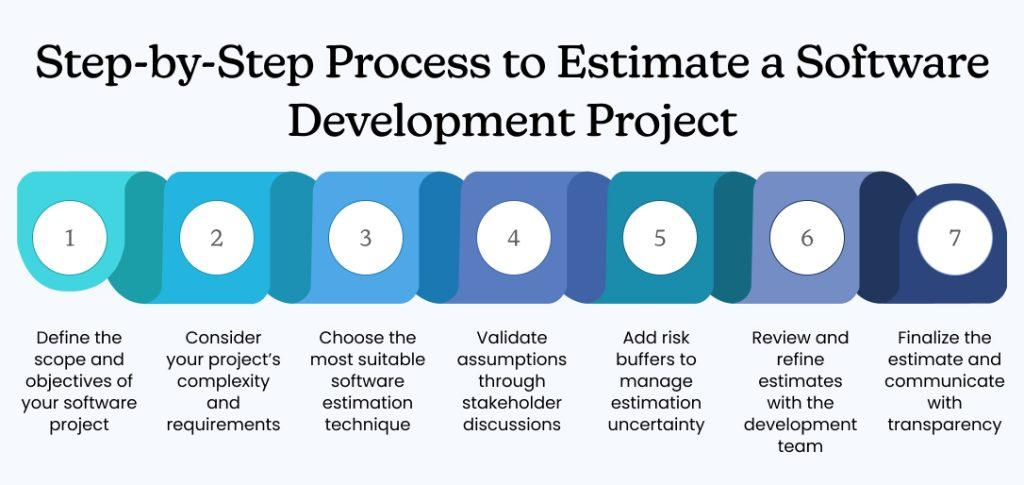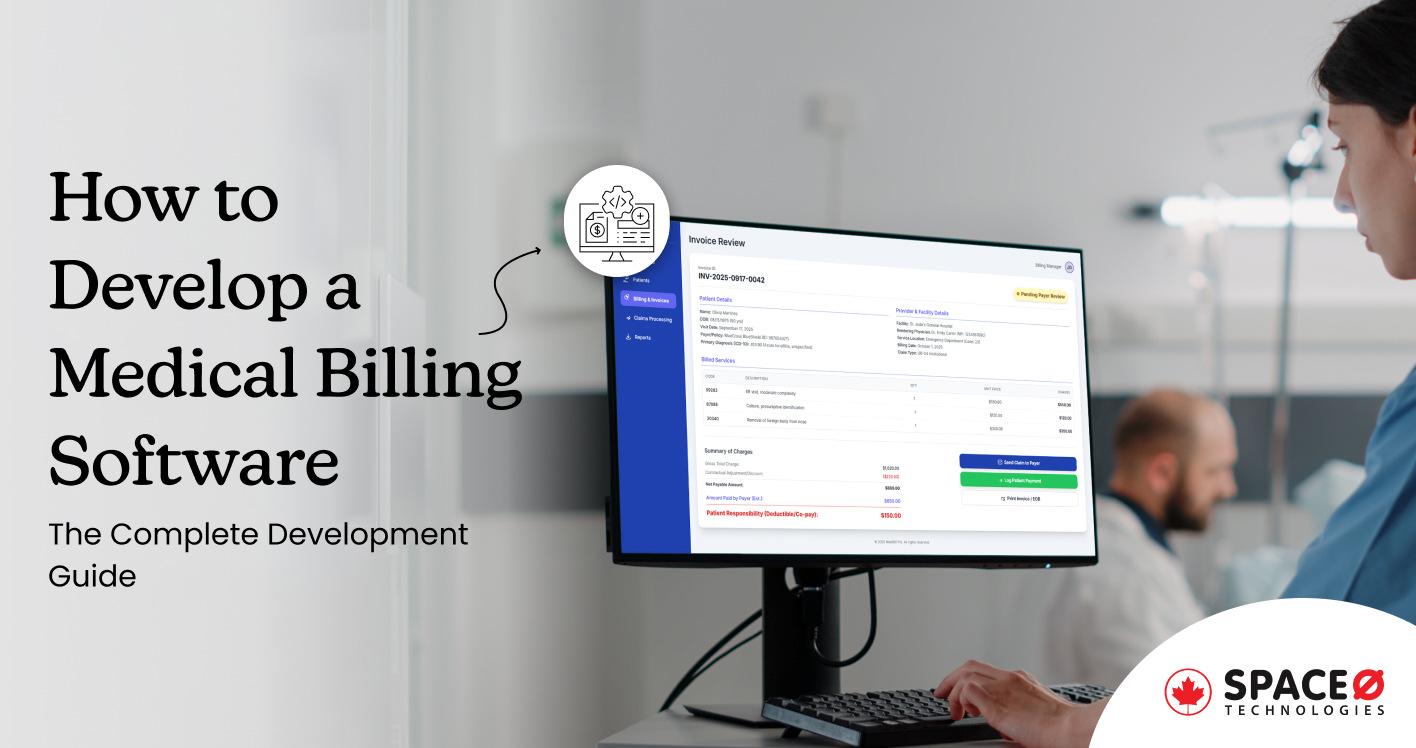
A Guide to Software Development Estimation [ Techniques + Process + Tools]
Deadlines slip. Budget stretch. Clients lose confidence.
And most of the time, the problem lies in how the effort was first calculated.
Even well-planned software projects can begin to break down simply because the estimates were inaccurate.
The scope was unclear.
Timelines were built on rough guesses.
The people responsible for developing the software were never consulted before the numbers were set.
If you are running a software project or managing a delivery team, you have likely felt this pressure before, right?
Don’t want to watch your other project break due to a bad estimate?
Want your next estimate to match the delivery?
At Space-O Technologies, a custom software development company with over 8 years of experience delivering more than 300 projects, we’ve seen these estimation challenges across Fortune 500 companies and startups alike. Let’s address your queries.
Here is an explanation of the challenges, techniques, types, process, and tools used in software development estimation.
What is Software Development Estimation?
Software development estimation is a process of predicting the total efforts, budget, time, and resources required to develop a software product. It’s less about guessing a delivery date and more about creating a realistic plan based on the current scope and requirements. This estimation becomes a crucial part of the overall software development process and directly impacts your software development cost.
A reliable estimate provides you with a general view of the timeline, what it might cost, and whether the project fits within the expected business outcomes or not.
For example, suppose a company wants to build software. Let’s say it’s a CRM dashboard that includes live reporting features. Initially, this might look like a task focused mainly on UI work. However, a closer look reveals complexities such as server-side filtering, user permissions, syncing live data, and mobile responsiveness.
If the estimation is not accurate, what seems like a short project stretches beyond initial expectations, leading to missed deadlines and budget overruns. Discover how precise estimation enhances clarity and control in your project planning.
- Set timelines that match the actual workload and development capacity.
- Control your budget by mapping out where time and money are most likely to go.
- Build confidence in your roadmap by showing the logic behind your delivery estimates.
- Address hidden challenges upfront to avoid delays and scope issues later.
- Enhance communication with clients, developers, and project managers.
- Demonstrate your reliability by providing estimates that closely align with delivery performance.
- Focus your team’s energy on features that bring the most value within the available time.
Let’s first discuss the problems you face with software development estimation.
Not Sure What Your Software Project Might Cost?
Share your idea with Space-O, and our experts will help you sketch out a time and budget range based on your goals, features, and tech stack.
Challenges in Estimating Software Projects with Solutions
Here are the challenges associated with estimating software development projects, along with the appropriate solutions.
1. Fails to clarify ambiguous requirements
The most happening reason for inaccurate estimates is starting the process when teams do not fully understand what needs to be developed. When requirements are vague, even developers are forced to make assumptions that are not aligned with what the clients want.
Additionally, misalignment in feature interpretation often leads to scope gaps and rework, which directly impact delivery, extending deadlines, and necessitating unnecessary development cycles.
Solution: Start with detailed requirement gathering before moving to estimation. Visual tools like wireframes and user stories help convert abstract inputs into precise deliverables. Schedule dedicated sessions to clarify grey areas before estimates are drafted. If you feel any part is still unclear, mark it as “to be defined” and exclude it from the estimate until it is resolved.
2. Struggles to control scope creep
Even detailed plans face changes as new concepts or needs surface during development. It’s common for clients to add requests or teams to uncover gaps after work begins. When there’s no control over additions, such additions gradually stretch the estimate and make delivery unpredictable. That gradual expansion is called scope creep. And it breaks both timelines and budgets.
Solution: Use a change management process. Any additions or changes to the scope must trigger a formal review and updated estimate. Define a baseline scope in the forecast and highlight what’s “in scope” vs. “out of scope.” Ensure transparency with clients about trade-offs and always document revised estimates.
3. Lacks access to historical data
Most teams start their estimations from scratch, which indirectly ignores the data available from past software development projects. Always remember, no historical reference means every estimate is more of a guess than a projection. This is challenging when choosing a software development company, as their track record and historical performance data become crucial factors in accurate estimation. The absence of data leads to overcompensation for easy tasks and underestimation of complex ones. Inaccurate or incomplete data creates risk for both planning and cost control.
Solution: Make historical estimation tracking part of your software engineering project workflow. Track estimated vs. actual hours by module or feature to find patterns. These logs serve as a reference when estimating similar tasks later. Use these records to identify where assumptions went wrong and refine your current estimation process accordingly.
4. Misses support from experienced teams
There are instances where project managers or sales teams estimate without consulting developers or architects. Such estimates miss critical implementation details, leading to surprises during development. Understanding the roles in the software development team and ensuring a proper software development team structure can prevent these estimation gaps.
The result?
You get a delivery plan that does not account for actual development constraints or platform-specific issues.
Solution: For improving estimation accuracy, senior engineers and architects needs to be included in the estimation process. Senior input anchors your estimates in real-world effort and technical reality. What else you can do is to use collaborative software estimation techniques like Planning Poker to collect input from across the team.
5. Overlooks estimation biases
Estimations rely heavily on human judgment, which is prone to error. Some teams cut too close, while others add safety nets that inflate the timeline unnecessarily. Anchoring bias (getting stuck on initial figures) or recency bias (basing estimates on the last project) can skew expectations.
Solution: Apply proven methods that reduce bias, like Three-Point Estimation (best case, worst case, most likely). Ask your teams to justify each estimate with assumptions, then review them collectively. This minimizes guesswork and centers the process on reasoned input and historical data.
Want to know the techniques used for the estimation? Let’s check each in detail.
Estimation Techniques Used in Software Development Projects
In software development, estimation isn’t a numbers game. Estimation involves selecting a method that suits the clarity and complexity of your project. The technique you apply directly affects how realistic your timelines, budgets, and delivery plans are. While some methods are fast and straightforward, others are data-driven and collaborative. Let’s explore each one.
| Software Estimation Techniques | How It Works | Best Used When | Limitations |
|---|---|---|---|
| Function Point Analysis (FPA) | Estimates based on the number and complexity of user inputs, outputs, files, and interfaces | Enterprise projects or when precise documentation is available | Requires training and standardized documentation to be effective |
| Work Breakdown Structure (WBS) | Breaks the project into smaller tasks or modules, each estimated separately | Scope is defined and needs to be planned in detail | Can become overwhelming for large or evolving projects |
| Three-Point Estimation | Uses optimistic, pessimistic, and most likely values to calculate an average | There’s uncertainty or multiple possible outcomes per task | Requires discussion and buy-in from experienced team members |
| Planning Poker | Team votes on the effort for each task, then discusses discrepancies | Agile teams, sprint planning, or group estimation sessions | Relies on team alignment and familiarity with tasks |
| Parametric Estimation | Multiplies effort per unit (e.g., actual time per screen) across the entire project | Tasks are repetitive or data-driven (e.g., form creation) | Doesn’t work well for creative or logic-heavy features |
| Expert Judgment | Relies on estimates from experienced developers or architects | Teams lack time/data but have access to senior resources | Subjective, prone to bias if not validated with reference points |
One method does not fit all, right? What works best often depends on the team’s experience, the project’s stage, and how clearly the requirements are defined.
Rather than adhering to a single model, Space-O employs a combination of estimation strategies tailored to each project. For example, we break the project into smaller parts using WBS. Then, for complex or unclear features, we apply Three-Point Estimation to capture effort variability.
We rely on Planning Poker in Agile sprints to ensure that all effort discussions occur before coding begins. This approach aligns well with the principles of the agile software development life cycle. Combining these software estimation techniques helps us move from guessing to planning with confidence.
Combining these software estimation techniques helps us move from guessing to planning with confidence. And more importantly, it’s also how we help our clients plan better and set the foundation for project success. Now, let’s discuss the types of software estimation methods.
You’ve Got The Scope. We’ve Got The Method.
Estimation must match both your project and your process. Let Space-O help define a planning flow that sets you up for better and efficient delivery.
Types of Software Estimation Methods You Must Know
Not all estimation methods are meant to serve the same purpose. Depending on your project size, clarity, and delivery goals, choosing the right type is what separates a guess from a plan. Here is the table highlighting commonly used estimation methods.
| Estimation Method | Purpose | When to Use | How Space-O Applies It |
|---|---|---|---|
| Effort-Based Estimation | Predict effort in hours/days per task or feature | When the scope is clear and modular | Used after WBS to estimate time per development unit |
| Size-Based Estimation | Estimates based on size units, like story points | For Agile teams or when requirements evolve | Applied during sprint planning using Planning Poker |
| Top-Down Estimation | Estimates based on the overall project scope | Early-stage planning or fixed-bid projects | Used in the discovery phase to outline initial budget & timelines |
| Bottom-Up Estimation | Aggregate estimates of all sub-tasks | For detailed planning and custom builds | Applied post-scope finalization for accurate budgeting |
| Analogous Estimation | Uses similar past projects as reference | When historical data is available | Matched with internal project logs for faster projections |
These methods are not mutually exclusive. In practice, using a mix of estimation types leads to more consistent and realistic outcomes.
Step-by-Step Process to Estimate a Software Development Project

Here is the step-by-step process you must follow for practical software development estimation.
Step 1. Define the scope and objectives of your software project
Estimating effort without knowing the project’s purpose, target audience, and expected outcomes leads to flawed planning. If your team doesn’t know what success looks like, even the best estimation technique won’t help.
A defined scope creates clear delivery boundaries for the team and involved parties. When the scope is unclear or undefined, teams end up chasing shifting targets, and estimates quickly fall apart. A structured scope captures details like:
- What exactly is being built? A dashboard? A mobile app? An internal tool?
- How should the user interact with the product?
- Are there specific performance, scalability, or security expectations?
- What is not included in the project?
Space-O initiates every estimation process with a discovery phase to minimize ambiguity. We use this time to collaborate with the client, clearly outline the scope, and identify any hidden constraints.
Step 2. Break down features into manageable development tasks
After defining the scope, the next logical step is to divide features into manageable development tasks. Even the most basic features carry layers of functionality, from backend logic to validation. Unless you break them down, you miss essential pieces in your estimate.
For example, consider a basic registration flow. A “User Registration” feature might include form creation, input validation, error handling, database setup, and API integration. All of which require separate time and attention.
By breaking features into smaller development units, teams get better clarity on where effort is going. This leads to more realistic time and cost planning.
Step 3. Choose the most suitable software estimation technique
No single estimation method guarantees project success for every case. The right choice is based on the depth of the requirement, access to developers, and the urgency of the planning. You can narrow down the proper method by reflecting on:
- Are the requirements clear and detailed enough to break into tasks?
- Is this a new build or similar to something we’ve done before?
- How much time do we have to prepare the estimate?
- Do we have access to the delivery team or just initial briefs?
- Are we working in an Agile environment or a fixed-scope setup?
- Is collaboration between team members possible at this stage?
If you are short on time but have solid historical data, an analogous estimation approach might be effective. If collaboration is possible and the scope is complex, consider methods such as planning poker or three-point estimation. If the scope is fixed and tasks are structured, bottom-up estimation gives solid results.
Just remember, you choose based on the level of detail you have, not just comfort or habit.
Step 4. Validate assumptions through stakeholder discussions
On paper, the plan makes sense. However, once execution begins, missing details start to become apparent. What happens is the front-end team assumed a static API, and the backend team thought authentication was out of scope. QA was never told mobile responsiveness was part of the plan.
The root issue? Each team operated with its interpretation of the requirements.
Planning won’t save a project if the teams aren’t synced from the start. Most breakdowns begin with assumptions that were made silently. What helps isn’t another tool or spreadsheet. It’s about the clarity that comes from direct conversations with those building the product, like design, development, QA, and product.
At this stage, take a break and ask, “Does this still make sense to everyone building it?” When teams agree on the assumptions, estimates become more than just numbers. They become commitments that people are aligned on.
Step 5. Add risk buffers to manage estimation uncertainty
Things go wrong. People take unplanned leave. That reliable API suddenly starts timing out. A third-party service introduces rate limits. The issue isn’t with the team’s capability; the plan just missed accounting for these risks. Understanding risk in software development and incorporating proper risk project management strategies into your estimation process is essential for project success.
This is what a risk buffer is designed to do. Let’s explore.
| Situation | Without Risk Buffer | With Risk Buffer |
|---|---|---|
| The developer hits a blocker in the backend logic | Timeline slips; other tasks pile up | An extra 10% time allows breathing room and recovery |
| Feature scope expands slightly | You end up negotiating the timeline mid-sprint | Scope changes absorbed without panic |
| QA finds edge-case bugs late | Testing overruns lead to rushed fixes | Buffer accounts for bug cycles without delaying release |
| The resource gets sick midway | Team reshuffles, morale drops, and velocity suffer | No chaos; buffer covers the fallback |
Risk buffers are a part of building accurate estimates that hold up when real-life variables start affecting the plan.
Step 6. Review and refine estimates with the development team
You can scope everything perfectly, but if the delivery team disagrees, the estimate won’t hold. The review session makes your estimate practical, not just theoretical. During this review, each team brings a valuable perspective:
- Developers flag what might be underestimated.
- Architects raise implementation challenges you didn’t account for.
- QA points out areas needing extra cycles for edge cases.
- Product teams clarify any misread feature expectations.
The team recalibrates the estimate using lessons from past work or known hurdles. When this collective feedback is used to refine the numbers, you no longer have a surface-level estimate.
Step 7. Finalize the estimate and communicate with transparency
After cross-team adjustments, the estimate reaches a point of readiness. Finalizing an estimate ensures everyone understands what’s behind the numbers. This clarity becomes particularly important when establishing your software development timeline and setting realistic expectations with stakeholders.
This internal clarity prevents confusion when pressure builds during execution. When sharing the estimate externally, consider this:
- State what’s included and what’s excluded.
- Show how risk buffers or assumptions cover potential challenges.
- Be honest about what might still be undefined or subject to change.
Transparency in estimates earns trust across teams and clients. Together, these steps turn software estimation from a rough guess into a structured, collaborative plan.
With a complete understanding of the process, let’s examine the tools used to simplify it.
Don’t Let Vague Numbers Turn Into Delivery Pressure
At Space-O, we refine estimates with your team and communicate them clearly to all stakeholders. No confusion mid-sprint.
Tools & Software that Simplify Estimating Software Development
Here are the tools and software used to simplify estimation for software development.
| Tool | Key Features | Best For | Pricing Model |
|---|---|---|---|
| Jira + Advanced Roadmaps | – Visual timelines with team capacity- Sprint-wise planning- What-if scenario modeling | Agile teams manage sprint-based delivery | Included in Jira Premium |
| Function Point Analysis Tools (like SEER-SEM) | – Size estimation based on user inputs and outputs- Historical database for benchmarking- Supports compliance tracking | Enterprise-grade or compliance-driven estimation | Custom pricing |
| Planning Poker | – Story-point-based collaborative voting- Team consensus building- Simple UI for real-time sessions | Collaborative Agile teams | Free & paid tools |
| Forecast.app | – AI-driven time and budget forecasts- Auto resource scheduling- Real-time task tracking | Mid-sized agencies & product companies | Tiered subscription |
| Monday.com + Workload | – Task-based effort planning- Workload visibility across teams- Drag-and-drop visual planner | Cross-functional delivery teams | Starts with a free tier |
These tools are meant to assist your team’s insights. But when used right, these tools reduce rework and make even complex estimates easier to trust.
How Space-O Provides Software Development Estimation with Clarity & Precision
Even skilled teams often miss the mark with estimation because the planning stage is rushed. Misalignment, unclear scope, or blind spots in effort planning are what derail good projects. That’s why, as a custom software development company, we align every estimate at Space-O with real-world logic, team insight, and past delivery performance.
1. We slow down at the start to avoid losing time later.
Careful discovery and internal reviews save weeks down the line.
2. We estimate with the people who’ll actually deliver.
Architects, engineers, and QA help shape realistic, accountable numbers.
3. We explain our estimate as clearly as we calculate it.
That way, teams and clients stay aligned, even when the scope evolves.
Strong estimates hold together through changes and keep everyone aligned. Following software development best practices and implementing a comprehensive software development strategy ensures your estimation process remains robust throughout the project lifecycle. If your next project needs clarity from day one, just request a callback.
FAQs About Software Development Estimation
How to estimate the cost of software development?
The first step is clarifying what needs to be built and why. Next, calculate how much time the development phase will take, is it in hours or days. Multiply the time required by each team member’s hourly rate across roles like design, development, and QA. At last, don’t forget to add a risk buffer for unexpected issues.
What is planning poker?
Planning poker is a collaborative method for estimating tasks in Agile teams. Every team member selects an effort value individually, using cards or online tools. Once numbers are shown, conversation helps bring the team to a single conclusion.
What is the 50-90 estimation technique?
The 50-90 rule provides two estimates: one where there’s a 50% chance of completing the task within the time (best guess), and one where there’s a 90% chance (more conservative). This technique helps manage risk by not relying on a single, rigid figure.
Which is the most reliable estimating technique for Agile development?
Agile teams mostly rely on relative estimation methods like story points, T-shirt sizing, or Planning Poker. These methods avoid specific hour estimates and focus on relative size or difficulty. Using past sprint data, these methods are used to estimate delivery more reliably. The key is consistent use and team alignment.
Editor's Choice

Telemedicine Software Development: A Complete Guide to Building Remote Healthcare Platforms

Medical Billing Software Development: The Complete Guide for Healthcare Providers

A Complete Guide to Pharmacy Management Software Development
All our projects are secured by NDA
100% Secure. Zero Spam
*All your data will remain strictly confidential.
Trusted by


Bashar Anabtawi
Canada
“I was mostly happy with the high level of experience and professionalism of the various teams that worked on my project. Not only they clearly understood my exact technical requirements but even suggested better ways in doing them. The Communication tools that were used were excellent and easy. And finally and most importantly, the interaction, follow up and support from the top management was great. Space-O not delivered a high quality product but exceeded my expectations! I would definitely hire them again for future jobs!”

Canada Office
2 County Court Blvd., Suite 400,
Brampton, Ontario L6W 3W8
Phone: +1 (437) 488-7337
Email: sales@spaceo.ca

